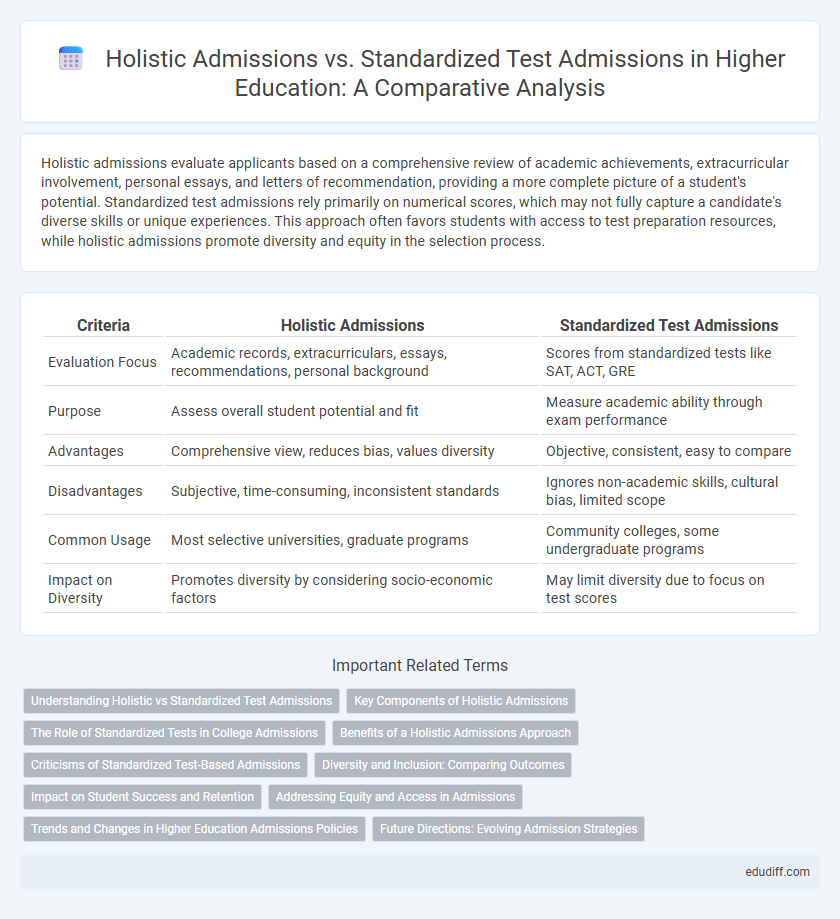Holistic admissions evaluate applicants based on a comprehensive review of academic achievements, extracurricular involvement, personal essays, and letters of recommendation, providing a more complete picture of a student's potential. Standardized test admissions rely primarily on numerical scores, which may not fully capture a candidate's diverse skills or unique experiences. This approach often favors students with access to test preparation resources, while holistic admissions promote diversity and equity in the selection process.
Table of Comparison
| Criteria | Holistic Admissions | Standardized Test Admissions |
|---|---|---|
| Evaluation Focus | Academic records, extracurriculars, essays, recommendations, personal background | Scores from standardized tests like SAT, ACT, GRE |
| Purpose | Assess overall student potential and fit | Measure academic ability through exam performance |
| Advantages | Comprehensive view, reduces bias, values diversity | Objective, consistent, easy to compare |
| Disadvantages | Subjective, time-consuming, inconsistent standards | Ignores non-academic skills, cultural bias, limited scope |
| Common Usage | Most selective universities, graduate programs | Community colleges, some undergraduate programs |
| Impact on Diversity | Promotes diversity by considering socio-economic factors | May limit diversity due to focus on test scores |
Understanding Holistic vs Standardized Test Admissions
Holistic admissions evaluate applicants based on a comprehensive review of academic achievements, extracurricular activities, personal essays, and recommendation letters, emphasizing individual potential and diverse experiences. Standardized test admissions primarily rely on quantitative scores from exams like the SAT or ACT to assess academic readiness and compare candidates objectively. Understanding the differences between these approaches highlights the balance between measuring raw academic ability and recognizing broader qualities that contribute to student success.
Key Components of Holistic Admissions
Holistic admissions evaluate applicants through multiple dimensions including academic achievements, extracurricular involvement, personal essays, letters of recommendation, and interviews to gain a comprehensive understanding of the candidate's potential. This approach values diversity, leadership qualities, resilience, and unique experiences beyond standardized test scores, addressing limitations such as test bias and socioeconomic disparities. By considering a wide range of key components, holistic admissions aim to create a diverse and well-rounded student body better equipped for complex academic and social environments.
The Role of Standardized Tests in College Admissions
Standardized tests play a significant role in college admissions by providing a uniform metric to assess student academic abilities across diverse educational backgrounds. These exams, such as the SAT and ACT, offer colleges a quantifiable measure to compare applicants objectively. Despite debates over their fairness, standardized test scores remain a critical factor in shaping admissions decisions and merit-based scholarships.
Benefits of a Holistic Admissions Approach
A holistic admissions approach evaluates candidates based on diverse factors beyond test scores, including extracurricular activities, leadership qualities, personal essays, and life experiences, offering a comprehensive view of an applicant's potential. This method enhances diversity, fosters equity, and identifies unique talents that standardized tests may overlook. Institutions adopting holistic admissions benefit from cultivating a dynamic and inclusive student body aligned with varied academic and social dimensions.
Criticisms of Standardized Test-Based Admissions
Standardized test-based admissions face criticism for overlooking diverse talents and socio-economic disparities, often favoring students with access to extensive test preparation resources. This method may reinforce systemic inequalities by disproportionately disadvantaging underrepresented minorities and low-income applicants. Critics argue holistic admissions provide a more equitable evaluation by considering a broader range of indicators including personal achievements, extracurricular involvement, and life experiences.
Diversity and Inclusion: Comparing Outcomes
Holistic admissions processes incorporate multiple factors beyond standardized test scores, resulting in a more diverse and inclusive student body by valuing experiences, backgrounds, and personal qualities. Research shows institutions using holistic criteria admit higher percentages of underrepresented minorities and first-generation college students compared to those relying solely on test scores. This approach fosters equity and broadens access to higher education opportunities, positively impacting campus diversity and cultural inclusion.
Impact on Student Success and Retention
Holistic admissions consider a broad range of student qualities, including extracurricular activities, personal essays, and letters of recommendation, leading to higher retention rates by identifying candidates with strong resilience and motivation. Standardized test admissions primarily focus on quantitative exam scores, often overlooking critical factors that contribute to long-term academic success and engagement. Research indicates students admitted through holistic processes demonstrate improved persistence and graduation rates compared to those selected solely by standardized test performance.
Addressing Equity and Access in Admissions
Holistic admissions evaluate applicants through multiple dimensions such as extracurricular activities, personal essays, and letters of recommendation, promoting a more equitable approach that considers diverse backgrounds and challenges beyond test scores. Standardized test admissions often overlook socioeconomic disparities and can disadvantage marginalized students who lack access to test preparation resources. By integrating holistic criteria, institutions can improve access and equity, fostering a more inclusive student body that better reflects varied experiences and potential.
Trends and Changes in Higher Education Admissions Policies
Higher education admissions policies increasingly favor holistic admissions, which evaluate applicants through diverse criteria such as extracurricular activities, personal essays, and recommendation letters, reflecting a broader understanding of student potential. Standardized test admissions face declining emphasis due to concerns over equity and accessibility, prompting many institutions to adopt test-optional or test-blind policies. These shifts align with data showing improved diversity and inclusivity in student populations at colleges prioritizing holistic evaluations.
Future Directions: Evolving Admission Strategies
Higher education institutions are increasingly adopting holistic admissions to capture a broader spectrum of student potential beyond standardized test scores, integrating diverse criteria such as extracurricular achievements, personal essays, and letters of recommendation. Data shows that universities implementing holistic strategies report improved student retention and diversity, which align with evolving educational equity goals. Emerging technologies like AI-driven analytics are being leveraged to refine admissions processes, enabling personalized assessments that predict academic success more accurately than traditional standardized tests.
Holistic Admissions vs Standardized Test Admissions Infographic

 edudiff.com
edudiff.com